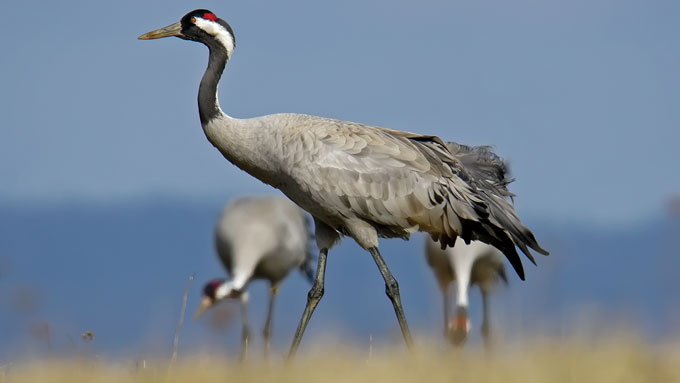It was a cold, overcast Saturday morning in Salem, Ore., when Jesse Laney set out to catch a glimpse of a painted bunting. He’d heard earlier that week through a birding WhatsApp group that this vibrant, rainbow-colored bird was in the area. Painted buntings (Passerina ciris) are common in places like Texas and the northern parts of Mexico, but a rarity in Oregon. Laney and his sons raced to the site and began searching — but the bird eluded them.
He wasn’t too disappointed, though. Just the chance of seeing a rare bird “scratches the ever-present itch of participating in a small bit of discovery,” says Laney, an ecologist at Oregon State University in Corvallis.
That itch has now inspired research debunking a popular myth among birders: That a rare bird sighting leads to more sightings of other rare bird species because birders flock to an area to find the initial bird. This phenomenon is called the Patagonia Picnic Table Effect.
 Common crane (Grus grus) sightings are rare in the Pacific Northwest. In 2020, ecologist Jesse Laney spotted one in Northern California.Thomas Landgren/Flickr (CC BY-NC-ND 2.0)
Common crane (Grus grus) sightings are rare in the Pacific Northwest. In 2020, ecologist Jesse Laney spotted one in Northern California.Thomas Landgren/Flickr (CC BY-NC-ND 2.0)
Its origin story dates back to sometime in the 1960s or ‘70s. Though details are a bit unclear, birders saw a rare black-capped gnatcatcher, or a pair of rose-throated becards, in Patagonia, a town near the Arizona-Mexico border. Word got around and birders descended on the town, which led to sightings of other rare birds, including a five-striped sparrow and a yellow grosbeak, according to some accounts.
To determine if such discovery bonanzas are one-off events or a common occurrence, Laney and his colleagues analyzed data from 2008 to 2017 from the online database eBird. Avid birders typically upload their checklists — that is, birds they have spotted on an outing — to the site.
The team identified 273 so-called mega-rarities mostly in the continental United States; these are the hardest-to-find birds, either because there are so few of them or because they rarely show up in some geographical locations. The researchers then evaluated rare bird discovery rates before and after crowds raced to where those ultra-uncommon birds were spotted.

Sign Up For the Latest from Science News
Headlines and summaries of the latest Science News articles, delivered to your inbox
Client key* E-mail Address* Go
Thank you for signing up!
There was a problem signing you up.
The rates remained essentially the same, the team reports January 21 in PeerJ, at 8 detections per 1,000 checklists. Birders had no better chance of finding a second species of rare bird in an area where there was a recent rare bird sighting than they did during routine birding.
This belief that one success can lead to more isn’t limited to the birding community. When an athlete magically makes one shot after another, that streak is referred to as the hot hand effect (SN: 1/12/12). We want to believe such patterns exist, says Andreas Wilke, a psychologist at Clarkson University in Potsdam, N.Y. That thinking once gave humans an evolutionary advantage when it came to such survival skills as finding food, he says. “It’s a very adaptive thing to do but it can misfire in modern environments when we look at very random distributions of things and start to see patterns that don’t exist.”

